Discover 11 hidden attractions, cool sights, and unusual things to do in Bristol (United States). Don't miss out on these must-see attractions: Linden Place, Blithewold Mansion, and Mount Hope Bridge. Also, be sure to include Bristol Ferry Light in your itinerary.
Below, you can find the list of the most amazing places you should visit in Bristol (Rhode Island).
Table of Contents
Linden Place
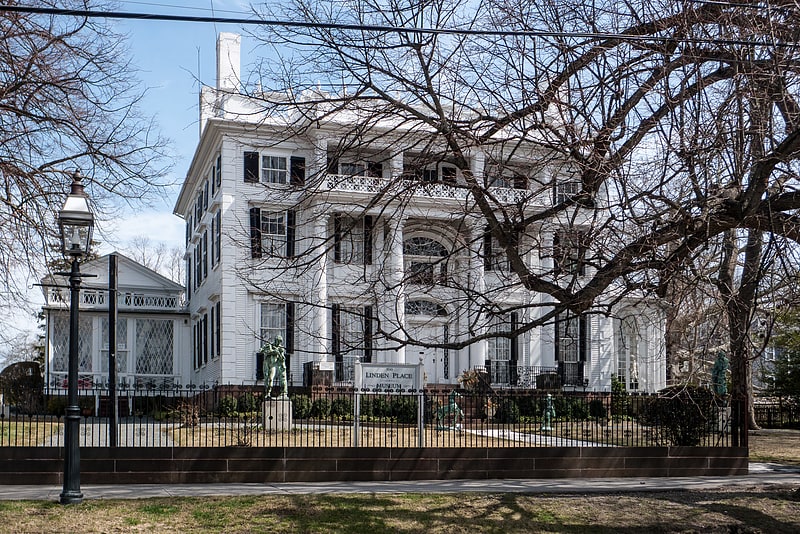
Museum in Bristol, Rhode Island. Linden Place mansion is a Federal-style mansion located in Bristol, Rhode Island. It was built in 1810 by slave trader, merchant, privateer and ship owner General George DeWolf and was designed by architect, Russell Warren. The mansion now operates as a historic house museum.
Built in the Robert Adam–inspired Federal style, popular in the early decades of the new American nation, Linden Place magnificently reflects the prosperity of the DeWolf slave trading merchant princes and the exquisite Adamesque Federal taste inspired by the architecture of ancient Greece and Rome. Linden Place is one of the best examples of Federal architecture in New England, from the magnificent Palladian windows to the fluted Corinthian columns, which gracefully flank the front entrance to the mansion. Also of architectural significance are the later added Gothic conservatory and four-story spiral staircase.
Tour highlights include tales of DeWolf family exploits, from their privateering and slave trading to their financial ruin and triumphant return to prosperity during Victorian times. Residents included family members Samuel Pomeroy Colt, founder of United States Rubber, now Uniroyal, his mother Theodora DeWolf Colt, who as Madam Colt ran Bristol Society from Linden Place as if she were Queen Victoria, and the great actress Ethel Barrymore who married in to this most prominent of American families. The mansion sits on 1.8 acres of sculpture-filled gardens where there are Greek bronzes and an 18th century gazebo.
Today the estate is sponsored by the non-profit Friends of Linden Place, which was created in 1989, based on the urgent need to save the magnificent 1810 DeWolf mansion from destruction or development. Due to the formidable drive of the earliest volunteers, the “crown jewel” of Bristol’s historic waterfront district was saved and is today maintained through visitation, fundraisers, grants and memberships.
The mansion was prominently featured in Traces of the Trade: A Story from the Deep North, a 2008 film documentary about the DeWolf family and the legacy of the slave trade in the North of the United States. It was used as a filming location for the 1974 movie The Great Gatsby.
The Bristol Art Museum occupies the former carriage house at Linden Place, with its entrance located at 10 Wardwell Street, Bristol, RI.[1]
Address: 500 Hope St, 02809-1808 Bristol
Blithewold Mansion
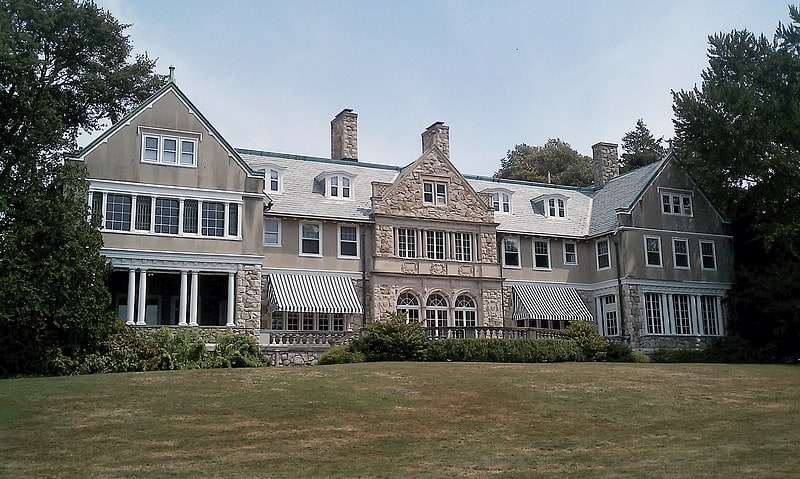
Tourist attraction in Bristol, Rhode Island. The Blithewold Mansion, Gardens and Arboretum is an arboretum of 13 hectares, located at 101 Ferry Road, Bristol, Rhode Island, midway between Newport and Providence, Rhode Island, on Bristol Harbor with views over Narragansett Bay. It includes a mansion, with a 4 hectares lawn and over 300 species of woody plants in its arboretum and gardens, including both native and exotic species.
The Mansion and its grounds were established in the 1890s by Augustus and Bessie Van Wickle as their summer retreat. Augustus Van Wickle was from Hazleton, Pennsylvania, with a fortune in the coal-mining business and a donor of the Van Wickle Gates at Brown University. Today's grounds are primarily the design of John DeWolf, and date between 1896 and 1913. The property was listed on the National Register of Historic Places in 1980.
Blithwold's grounds include species from North America, Europe, China and Japan. Specimen trees include magnolia (Magnolia spp.), linden (Tilia spp.), Ginkgo (Ginkgo biloba), Black Tupelo (Nyssa sylvatica), Dawn Redwood (Metasequoia glyptostroboides), Franklinia (Franklinia alatamaha), Eastern Hemlock (Tsuga canadensis), various oaks (Quercus spp.) and beeches (Fagus spp.). Other notable trees include a weeping Pagoda Tree (Styphnolobium japonicum 'Pendula'), Hiba (Thujopsis dolabrata), Katsura (Cercidiphyllum japonicum), and Sugi (Cryptomeria japonica). The grounds also include English Yews (Taxus baccata) and Eastern Junipers (Juniperus virginiana), as well as what is claimed to be the largest Giant Sequoia (Sequoiadendron giganteum) on the East Coast, planted in 1911, and currently about 100 feet (30 m) tall.
Blithewold's Bamboo Grove covers an area nearly the size of a tennis court, and is planted with Phyllostachys aureosulcata, the Yellow-groove bamboo, which grows to 10 metres (33 ft) tall.
Blithewold has maintained contacts with the Arnold Arboretum ever since 1926, when staff botanists visited Blithewold to see the Chinese toon tree (Toona sinensis) in flower for what was believed to be the first time in the United States.[2]
Address: 101 Ferry Rd, 02809-2902 Bristol
Mount Hope Bridge
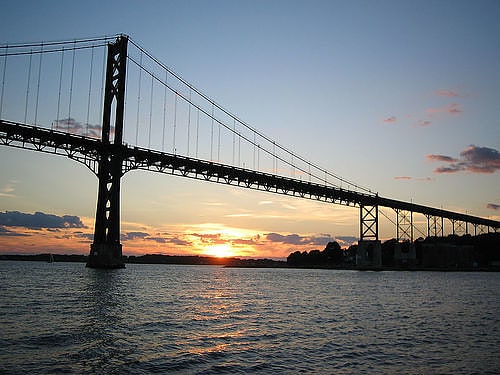
Suspension bridge in Bristol, Rhode Island. The Mount Hope Bridge is a two-lane suspension bridge spanning the Mount Hope Bay in eastern Rhode Island at one of the narrowest gaps in Narragansett Bay. The bridge connects the Rhode Island towns of Portsmouth and Bristol and is part of Route 114. Its towers are 285 feet tall, the length of the main span is 1,200 feet, and it offers 135 feet of clearance over high water. The total length of the bridge is 6,130 feet. The railing along the bridge is only 35 inches and since 2016 there is a dedicated coalition advocating for the installation of physical safety/suicide prevention barriers on Mount Hope Bridge.[3]
Bristol Ferry Light

Lighthouse in Bristol, Rhode Island. Bristol Ferry Light is a historic lighthouse in Bristol, Rhode Island, United States. It is located on the shores of Narragansett Bay at Bristol Point, the northern land point of Mount Hope Bay at the base of the Mount Hope Bridge.
The two-story square brick lighthouse was built in 1855, along with an attached 1+1/2 story brick keeper's house. Its use was discontinued in 1927 with the construction of the Mount Hope Bridge, and a replacement automated beacon across Ferry Road. Prior to the construction of the bridge, a ferry operated between Bristol and Aquidneck Island, and the light assisted the ferry service. The Bristol Ferry Lighthouse was added to the National Register of Historic Places in 1988, at which time it was a private residence.[4]
Herreshoff Marine Museum

Museum in Bristol, Rhode Island. The Herreshoff Marine Museum, located in Bristol, Rhode Island, USA, is a maritime museum dedicated to the history of the Herreshoff Manufacturing Company, yachting, and the America's Cup. The Herreshoff Manufacturing Company was most notable for producing sailing yachts, including eight America's Cup defenders, and steam-powered vessels.
The museum, situated near Narragansett Bay on the grounds where the manufacturing company once stood, has a collection of over sixty boats including Nathanael Greene Herreshoff's Clara, built in 1887, Harold Vanderbilt's Trivia, and the 1992 IACC yacht, Defiant. The Nathanael Greene Herreshoff Model Room contains over 500 yacht and steam yacht models and the Rebecca Chase Herreshoff Library holds a collection of books and manuscripts related to the company, the Herreshoff family, and yachting. The museum also hosts symposia related to yacht design and operates a sailing school.[5]
Address: 1 Burnside St, 02809 Bristol
Juniper Hill Cemetery
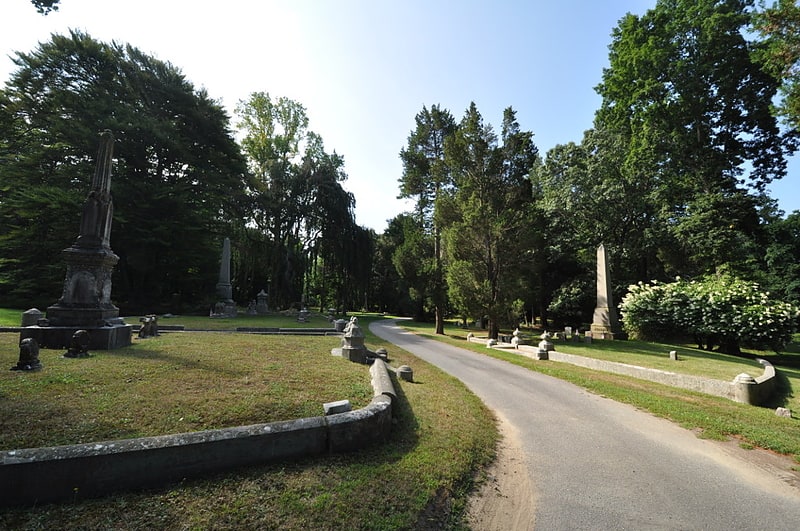
Cemetery in Bristol, Rhode Island. Juniper Hill Cemetery is a historic cemetery at 24 Sherry Avenue in Bristol, Rhode Island founded by George R.Usher, James D'Wolf Perry, Byron Diman, Ambrose E. Burnside, James H. West, Charles H. R. Doringle, and Lemanuel W. Briggs. The original 22 acres were purchased from the descendants of Levi DeWolf, a local farmer and slave hauler, in 1855, and the cemetery corporation that owns it was chartered in January 1856. It is a fine example of the mid-19th century rural cemetery movement, with winding lanes and paths. The landscape was designed by Niles Bierragaard Schubarth, who had done similar work at other Rhode Island cemeteries. Its main entry is a massive stone gate built in 1876, and there is a gate house just inside, designed by Clifton A. Hall and constructed from granite quarried on site.
The cemetery was listed on the National Register of Historic Places in 1998.[6]
Coggeshall Farm Museum
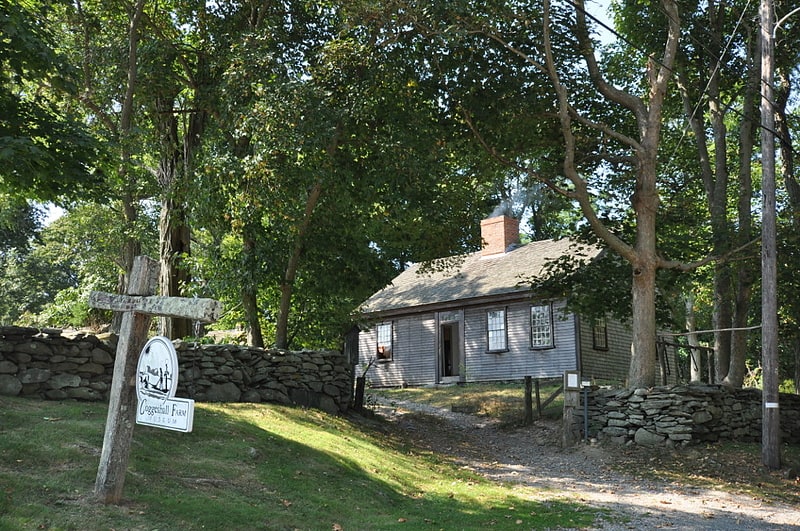
Museum in Bristol, Rhode Island. Coggeshall Farm Museum is a non-profit farm museum in Colt State Park in Bristol, Rhode Island, U.S.A.
The eighteenth century coastal tenant farm is located on 48 acres of land in Bristol and features interpreters and authentic reenactments of farm life in the year 1799. In the early nineteenth-century Wilbur and Eliza Coggeshall were tenant farmers at the farm. The Coggeshall's son, Chandler Coggeshall, later became a politician and helped to found what it now the University of Rhode Island in 1888. The farm later became part of the Colt Estate. In 1965 the State of Rhode Island purchased the Colt Estate for use as a state park, and the Bristol Historical Society petitioned the state for permission to preserve the farm house on the property as a museum. In 1968 the Bristol Historical Society signed a lease and constructed various outbuildings. Coggeshall Farm Museum was established in 1973 to educate modern Americans about eighteenth century New England farm life.[7]
Address: 1 Colt Dr, 02809 Bristol
Mount Hope Farm

Bed & breakfast in Bristol, Rhode Island. Mount Hope Farm is a historic estate on Metacom Avenue in Bristol, Rhode Island, United States.[8]
Benjamin Church House
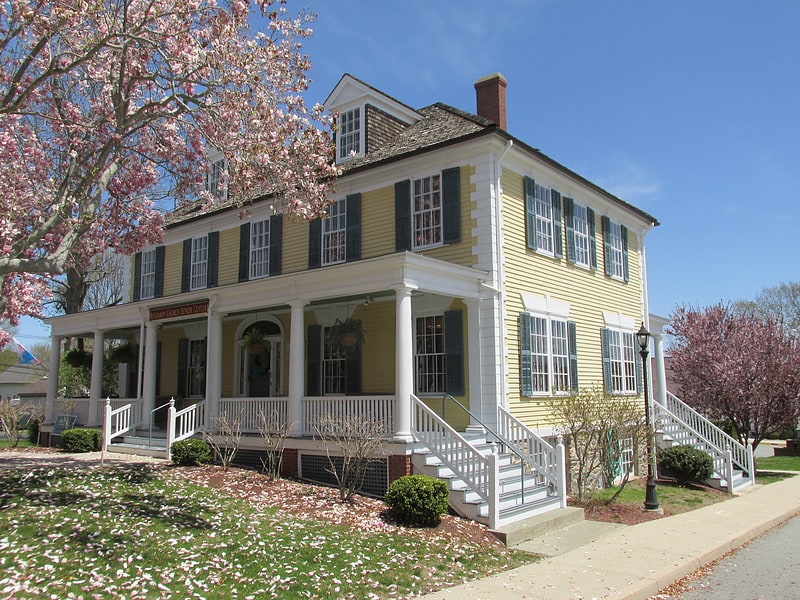
Benjamin Church House is a Colonial Revival house at 1014 Hope Street in Bristol, Rhode Island, U.S.A. It opened in 1909 as the "Benjamin Church Home for Aged Men" as stipulated by Benjamin Church's will. Beginning in 1934, during the Great Depression, it admitted women. The house was closed in 1968 and became a National Register of Historic Places listing in 1971. The non-profit Benjamin Church Senior Center was incorporated in June 1972 and opened on September 1, 1972. It continues to operate as a senior center.[9]
Address: 1020 Hope St, Bristol
Bristol County Jail

Jail in Bristol, Rhode Island. Bristol County Jail is a historic jail at 48 Court Street in Bristol, Rhode Island and home to the Bristol Historical and Preservation Society.
The jail was built on the site of a previous jail house dating to 1792 and salvaged materials were used extensively in the new construction. The present Bristol County Jail consists of a 36.5-foot-wide (11.1 m) by 46.4-foot-long (14.1 m) center hallway in a 2+1⁄2-story stone structure topped with a gable roof. The jail accommodated both the inmates and the jailer's family. The first floor is believed to have been the family's parlor, dining room and kitchen on the west side and the east side the jailer's reception room, office and storage room. The second floor housed the family's bedrooms and the inmates' cells, with low, medium and maximum security cells. The maximum security cells in the southeast portion of the jail had no heat, light or sanitary facilities and were enclosed by 2-foot (0.61 m) exterior stone walls and built atop thick floor timbers supported by 2-foot-thick (0.61 m) solid brick wall and further supported by a fieldstone wall from the cellar.
In 1859, a rectangular 20-foot-wide (6.1 m) by 43.2-foot-long (13.2 m) two-story rear addition was added to common southeast wall of the jail. Made of cut granite blocks and topped with a flat roof, the addition added five cells on each of its two levels. The jail was discontinued by the State of Rhode Island in June 1957 and the Bristol Historical Society (later the Bristol Historical and Preservation Society) leased the property following a fire at the Rogers Free Library. The Bristol Historical Society removed partitions in the first floor and added new access points as part of its renovations, including the removal of the internal east chimney. However, the building retains much of its unaltered interior features, and the jail cells are used by the Society as a public exhibit. The Bristol County Jail was added to the National Register of Historic Places in 1973 and currently serves as the Historical Society headquarters.[10]
Bristol Customshouse and Post Office
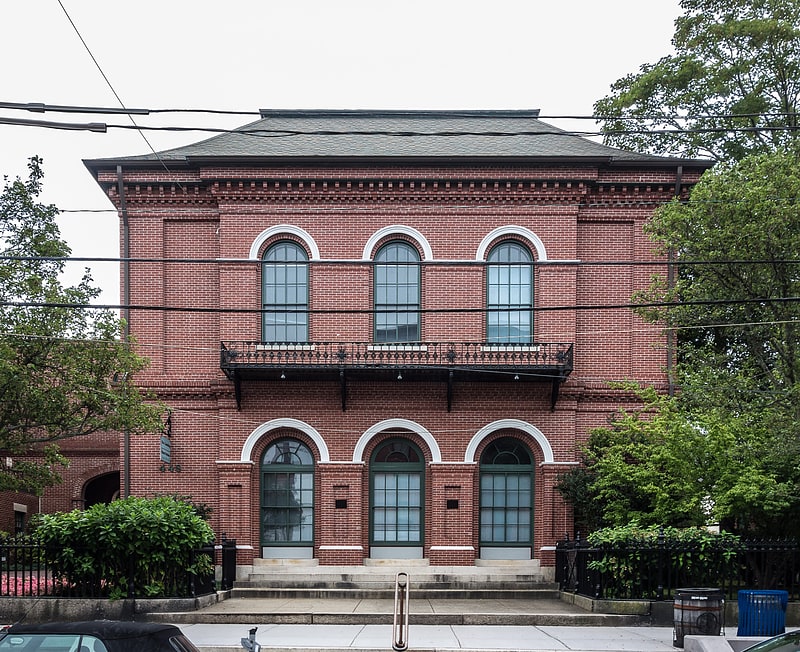
Building in Bristol, Rhode Island. Bristol Customshouse and Post Office is a historic two-story rectangular Italian palazzo style brick building that was used as a post office and customshouse in Bristol, Rhode Island, United States. The land for the site was acquired for $4,400. The building was designed by Ammi B. Young and completed in 1858 for a cost of $22,135.75. The building roughly measures 46 feet by 32 feet and is constructed of deep red brick and has three arched openings on each of its sides and stories that are lined with sandstone moldings. The archways protrude from the side of the building and the center archway serves as the first floor with the adjacent archways housing large windows that are barred with iron. As it typical of the style, the second floor is more elaborate with a shallow balcony of iron supported by iron brackets and the paneling of the upper facade's surmounting entablature is elaborately decorative. The sides and rear are similar to the front facade, but include blind recesses and the molding is of a browner sandstone.
The building was abandoned in 1962 and acquired by the Young Men's Christian Association (YMCA) in 1964. The YMCA has an adjacent structure and used the building as an ante-space until 1990. Currently, the building is used as offices. The Bristol Customshouse and Post Office is historically significant as it is an example of the Italian palazzo mode of architecture. The building was added to the National Register of Historic Places in 1972.[11]